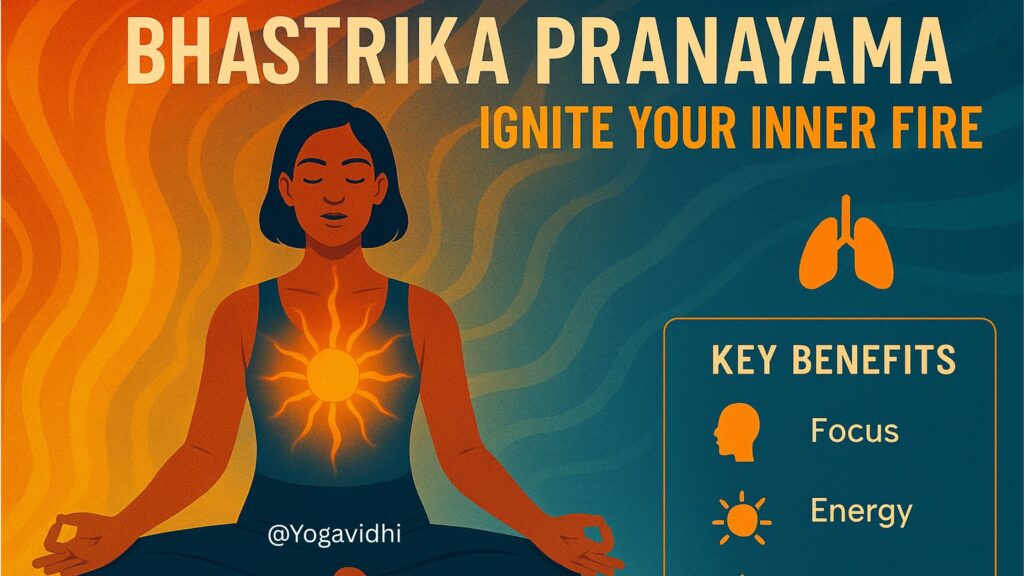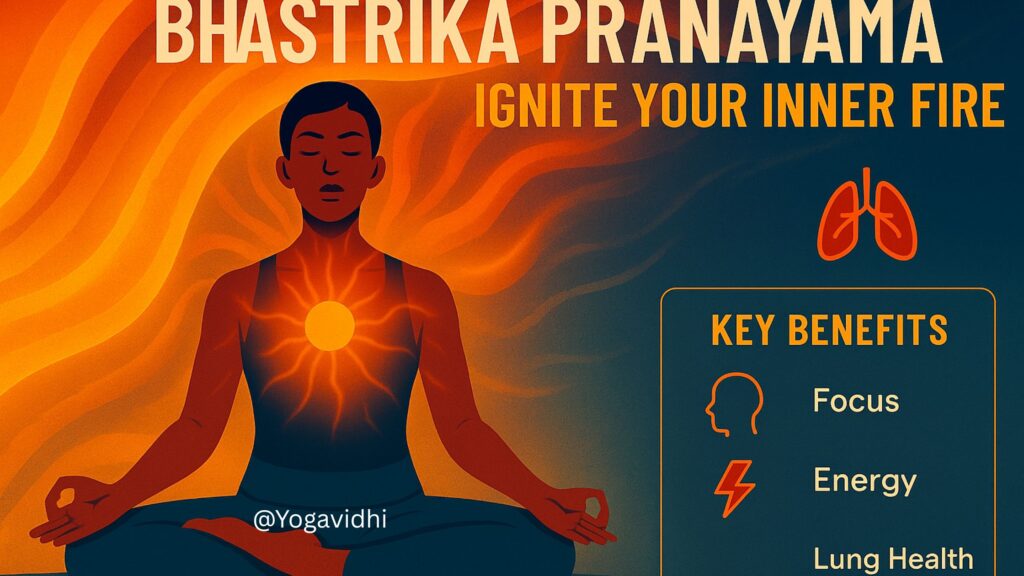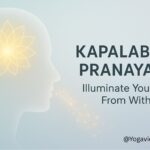Among the many powerful breathing techniques in yoga, Bhastrika Pranayama—often called the Breath of Fire—stands out for its ability to energize the body, cleanse the mind, and awaken inner vitality. The word Bhastrika comes from the Sanskrit term for “bellows,” referring to the forceful in-and-out breathing that mimics the action of a blacksmith’s tool pumping air to ignite fire.
For centuries, yogis have practiced this dynamic pranayama to boost prana (life force energy), enhance mental focus, and prepare the mind for deep meditation. In modern times, Bhastrika Pranayama is gaining popularity for its scientifically proven health benefits, from increasing oxygen intake to improving mental clarity.
Bhastrika Pranayama, or “bellows breath,” is a yogic breathing practice that uses powerful, rapid inhalations and exhalations resembling a blacksmith’s bellows. It aims to invigorate the body and mind, clear the respiratory passages, and may support better respiratory and cardiovascular health, as noted by various health and wellness sources.
Table of Contents
What is Bhastrika Pranayama?
Bhastrika Pranayama is a yogic breathing exercise involving rapid, forceful inhalations and exhalations through the nose, powered by diaphragmatic movement. Unlike normal breathing, where inhalation and exhalation are passive, in Bhastrika both phases are active and intense.
It is often confused with Kapalabhati Pranayama, but there’s a key difference: in Kapalabhati, exhalation is forceful and inhalation is passive, while in Bhastrika, both inhalation and exhalation are equally forceful and controlled.
This pranayama is practiced to increase lung capacity, clear the mind, stimulate metabolism, and activate dormant energy channels.
Benefits of Bhastrika Pranayama
Practicing Bhastrika Pranayama regularly can bring a wide range of benefits, touching the physical, mental, and spiritual aspects of well-being.
Physical Benefits
- Improves lung function: Strengthens respiratory muscles, enhancing oxygen intake.
- Boosts metabolism: Increases body heat and supports calorie burning.
- Improves circulation: Enhances blood flow, delivering oxygen and nutrients to every cell.
- Strengthens immunity: Helps expel toxins and supports overall health.
Mental & Emotional Benefits
- Reduces stress and anxiety: The rhythmic breathing pattern calms the nervous system.
- Enhances focus and memory: Increases oxygen supply to the brain, sharpening mental clarity.
- Elevates mood: Helps release endorphins and improves emotional stability.
Spiritual Benefits
- Activates prana: Stimulates life force energy, preparing the mind for meditation.
- Balances chakras: Especially powerful for activating the Manipura (Solar Plexus) Chakra.
- Purifies nadis: Clears the energy channels for better spiritual flow.
How to Do Bhastrika Pranayama (Step-by-Step Guide)
Step 1: Sitting Posture
Sit comfortably in Padmasana (Lotus Pose), Sukhasana (Easy Pose), or Vajrasana (Thunderbolt Pose). Keep your spine straight and shoulders relaxed.
Step 2: Hand Placement
Place your hands on your knees in Gyan Mudra (thumb and index finger touching lightly).
Step 3: Breathing Technique
- Inhale deeply and forcefully through the nose, expanding your lungs fully.
- Exhale with equal force, contracting your abdominal muscles.
- Keep both inhalation and exhalation active and rhythmic.
Step 4: Speed & Duration
- Beginners: Start with slow, controlled breaths—10–15 cycles.
- Intermediate: Practice medium pace—20–30 cycles.
- Advanced: Rapid pace—up to 50–60 cycles per round.
Step 5: Rest
After completing one round, close your eyes, breathe normally, and relax for 30–60 seconds before starting the next.
Types of Bhastrika Pranayama
- Slow Bhastrika – Ideal for beginners, focusing on deep and steady breathing.
- Medium-Paced Bhastrika – Builds stamina and strengthens respiratory muscles.
- Fast Bhastrika – Advanced level, rapidly energizing and detoxifying the body.
Read More: Nadi Shodhana Pranayama: Detoxify Your Mind and Body with Alternate Nostril Breathing
Read More: Pranayama: Harness the Power of Breath for Health, Clarity, and Inner Peace
| Aspect | Details |
| Meaning | Bhastrika means “bellows” in Sanskrit, referring to forceful in-and-out breathing. |
| Alternate Name | Breath of Fire |
| Key Difference from Kapalabhati | In Bhastrika, both inhalation and exhalation are forceful; in Kapalabhati, only exhalation is forceful. |
| Benefits – Physical | Improves lung capacity, boosts metabolism, enhances circulation, strengthens immunity. |
| Benefits – Mental | Reduces stress, increases focus, improves mood, enhances memory. |
| Benefits – Spiritual | Activates prana, balances chakras (especially Manipura), purifies nadis. |
| Types | Slow Bhastrika (beginners), Medium-paced Bhastrika, Fast Bhastrika (advanced). |
| Best Time to Practice | Early morning on an empty stomach; also beneficial in winter. |
| Recommended Frequency | 2–3 rounds daily for beginners; up to 4–5 rounds for advanced practitioners. |
| Precautions | Avoid during high BP, heart disease, epilepsy, hernia, pregnancy, or recent surgery. |
| Scientific Benefits | Improves oxygen utilization, balances nervous system, enhances metabolism, reduces oxidative stress. |
| Associated Chakra | Manipura (Solar Plexus) Chakra |
| Beginner Tips | Start slow, maintain rhythm, practice in a ventilated space, gradually increase rounds. |
Best Time & Frequency for Practice
- Best Time: Early morning on an empty stomach is ideal.
- Frequency: 2–3 rounds daily for beginners; advanced practitioners can do 4–5 rounds.
- Seasonal Tip: Particularly beneficial in winter due to its warming effect.
Precautions & Contraindications
While Bhastrika Pranayama offers immense benefits, it’s important to practice safely.
Avoid if you have:
- High blood pressure
- Heart disease
- Epilepsy
- Hernia
- Pregnancy
- Recent surgery
Safety Tips:
- Never overexert—stop immediately if you feel dizzy or breathless.
- Always learn under a trained yoga teacher before independent practice.
Scientific Perspective on Bhastrika Pranayama
Modern research supports the benefits of Bhastrika Pranayama. Studies show it:
- Improves lung capacity and oxygen utilization.
- Balances the autonomic nervous system.
- Enhances metabolism and calorie burning.
- Reduces oxidative stress and inflammation.
This makes it not just a spiritual exercise, but a scientifically validated wellness tool.
Bhastrika Pranayama & Chakras
Bhastrika Pranayama is strongly associated with activating the Manipura Chakra, located at the solar plexus. This chakra governs personal power, confidence, and vitality. Regular practice also helps balance the energy flow through Ida, Pingala, and Sushumna nadis, paving the way for deeper meditation and spiritual awakening.
Tips for Beginners
- Start with slow and steady breathing to build capacity.
- Practice in a quiet, well-ventilated space.
- Focus on rhythm rather than speed at the beginning.
- Gradually increase rounds as your stamina improves.
- Combine with meditation for deeper mental clarity.

Conclusion
Bhastrika Pranayama is more than just a breathing exercise—it’s a holistic practice that fuels your body, clears your mind, and uplifts your spirit. Whether you’re looking to boost energy, improve mental clarity, or deepen your meditation, this pranayama offers a time-tested pathway to wellness.
Start slow, listen to your body, and let the Breath of Fire ignite your inner vitality. In just a few weeks, you may notice higher energy, calmer thoughts, and a stronger connection to yourself—proof that the ancient wisdom of yoga still holds the key to modern health.
FAQ:
Q. Is Bhastrika Pranayama safe for everyone?
Ans: No. People with heart disease, high blood pressure, epilepsy, or pregnancy should avoid it without medical advice.
Q. How is Bhastrika different from Kapalabhati?
Ans: In Bhastrika, both inhalation and exhalation are forceful, while in Kapalabhati, only exhalation is forceful.
Q. Can I do Bhastrika every day?
Ans: Yes, daily practice is beneficial if done within safe limits.
Q. What are the side effects of overdoing Bhastrika?
Ans: Excessive practice can cause dizziness, fatigue, or breathlessness—always practice in moderation.
Q. Can Bhastrika Pranayama help in weight loss?
Ans: Yes, Bhastrika Pranayama increases metabolism, improves digestion, and boosts calorie burning by generating internal heat, making it a supportive practice for weight management when combined with a balanced diet and regular exercise.
Q. How long should I practice Bhastrika Pranayama in one session?
Ans: Beginners can start with 1–2 minutes (10–15 cycles) and gradually extend to 3–5 minutes per round. Advanced practitioners may practice longer, but always listen to your body and rest between rounds.
Q. What is meant by bhastrika pranayama?
Ans: Bhastrika Pranayama, or Bellows Breath, is a warming breathing technique that imitates the action of fanning a fire with a continuous stream of air. The term Bhastrika comes from Sanskrit, meaning “bellows,” and refers to the vigorous expansion and contraction of the abdomen and lungs throughout the practice.
Q. What is the difference between Kapalbhati and Bhastrika?
Ans: The key difference between Kapalabhati and Bhastrika lies in their breathing techniques: Kapalabhati emphasizes forceful exhalations with passive inhalations, while Bhastrika uses both forceful inhalations and exhalations. In Kapalabhati, the abdominal muscles drive the breath out, whereas in Bhastrika, both the chest and abdomen work together to produce deep, powerful breaths.
Q. Is Bhastrika good for lungs?
Ans: The study concludes that practicing Bhastrika Pranayama can activate normally unventilated lung areas, strengthen respiratory muscles, and enhance the elasticity of the lungs and chest, thereby improving overall ventilatory function.
Declaration Note:
We use third-party videos and images on https://yogavidhi.com/ for educational and illustrative purposes. All rights belong to their respective owners. No copyright infringement is intended.



